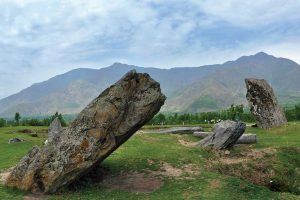Ranjit Hoskote in Open:
 SAY ‘KASHMIR’, and most people would reach for images of stone-throwing teenagers and harried soldiers. Every other aspect of life has been eclipsed by the protracted violence. Or been devalued as insufficiently urgent by comparison with the fight-to-the-death between the State and militant groups. For many of us, the first, instinctive, tragic response on hearing a Kashmiri place name is to locate it on a list of towns and villages associated with some horrible atrocity, some act of brutalisation. Such a list of place names would not—thankfully, not yet—feature Burzahom (Burzahama), 16 km northeast of Srinagar, and Gufkral, near Tral in the troubled Pulwama district.
SAY ‘KASHMIR’, and most people would reach for images of stone-throwing teenagers and harried soldiers. Every other aspect of life has been eclipsed by the protracted violence. Or been devalued as insufficiently urgent by comparison with the fight-to-the-death between the State and militant groups. For many of us, the first, instinctive, tragic response on hearing a Kashmiri place name is to locate it on a list of towns and villages associated with some horrible atrocity, some act of brutalisation. Such a list of place names would not—thankfully, not yet—feature Burzahom (Burzahama), 16 km northeast of Srinagar, and Gufkral, near Tral in the troubled Pulwama district.
These names are infused with the region’s deep history. ‘Burzahom’ enshrines burza, from the Sanskrit bhurja, the birch tree, on whose bark some of the earliest extant Vedic manuscripts were written. ‘Gufkral’ is, literally, the ‘potter’s cave’, and we recall that the kröjü, the potter’s wife, played a pivotal role in the Tantric chakra puja or wheel ritual. These sites—along with others such as Begagund, Hariparigom, Jayadevi-Udar, Olchibag, Pampore, Panzgom, Sombur, and Thajiwor—are associated with quite another period in Kashmir’s long history, and stones other than those pelted by protestors in the streets of Srinagar and Anantnag.
Burzahom and Gufkral are among the oldest Neolithic or New Stone Age sites in South Asia.
More here.
